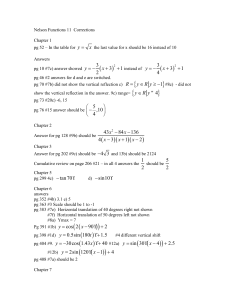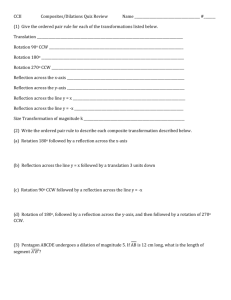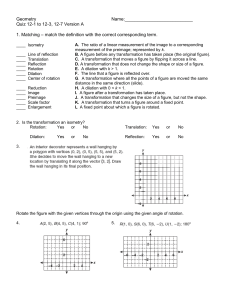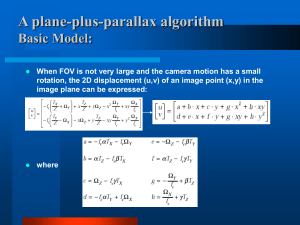Translations
advertisement
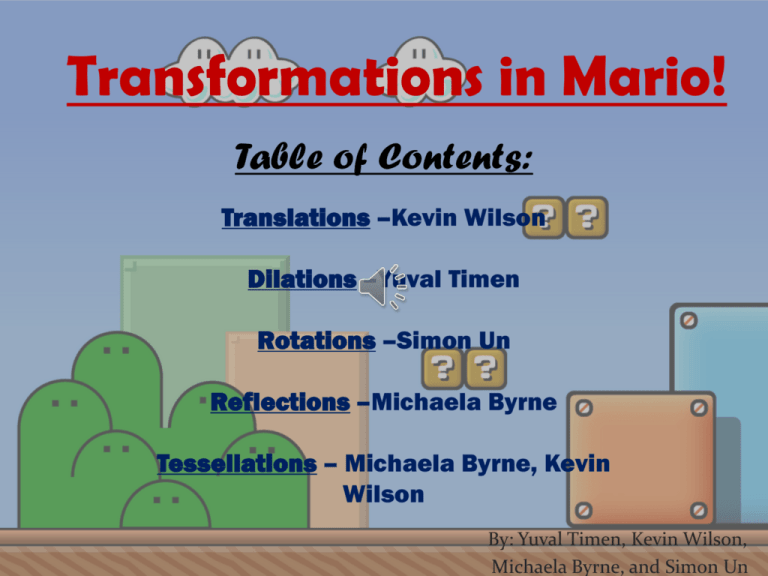
Transformations in Mario!
Table of Contents:
Translations –Kevin Wilson
Dilations –Yuval Timen
Rotations –Simon Un
Reflections –Michaela Byrne
Tessellations – Michaela Byrne, Kevin
Wilson
By: Yuval Timen, Kevin Wilson,
Michaela Byrne, and Simon Un
Translations
Translations
•
Translations are a transformation
that involves “sliding” a point or set
of points (object/shape)
•
Translations preserve length and
size.
•
The object is NOT flipped or rotated.
•
The shape looks exactly the same
except it is in a different place.
Vocabulary
•
Pre-image: The beginning point or
set of points under a
transformation, in this case a
translation
•
Image: The resulting point or set of
points under a transformation.
•
Isometry: An isometry is a
transformation of the plane that
preserves length.
•
Matrix: A rectangular grid of
numbers.
•
Vector: A quantity that has both
direction and magnitude.
Vocabulary (cont.)
•
Invariant: A figure or
property that remains
unchanged under a
transformation of the plane is
referred to as invariant. No
variations have occurred.
•
Translation Theorem: A
translation is an isometry.
•
Theorem 7.5: If lines k and m
are parallel, then a reflection
in line k followed by a
reflection in line m is a
translation.
Theorem 7.5
k
m
Reflection
If you reflect the object over line k and then reflect it
again over line m it is a translation.
Matrices
•
•
Matrix addition and subtraction can be
represented geometrically as a
translation of a shape on the plane.
If you wanted to move the square
below 2 units right and 1 unit up, you
would apply the translation matrix
which you would add to the original
points to get the new points.
−𝟐
𝟐
−𝟐
−𝟏
A
B
𝟐
𝟏
𝟐 𝟐
𝟏 𝟏
𝟏 𝟏
𝟐 −𝟏
C
Original points.
X coordinates
are on top, y on
bottom.
D
𝟐
𝟏
Translation Matrix.
You add these
numbers to the
corresponding
numbers of the
original points to get
the new points
below.
𝟎
𝟑
𝟎
𝟎
𝟑 𝟑
𝟑 𝟎
A’
B’
C’
D’
Component Form +
Vectors
•
If you have a picture like the one below, you
can write the translation (where the picture
moves to) in component form.
•
You do this by seeing how far over and up the
new point is.
•
Component form is written like this
<x,y>.
Up and over
• If you have a square
for example, and you
write <6,4>, you would
move every point 6
points right and 4
points up.
• If you do another
translation, for example
<3,5>, you can add the
vectors together to get
a new one like <9,9>.
Component Form +
Vectors
Any two vectors of the same
length and parallel to each
other are considered
identical. They need not have
the same initial and terminal
points. This is called a free
vector which is used here.
• To each free vector (or
translation), there corresponds a
position vector which is the
image of the origin under that
translation.
• Unlike a free vector, a position vector
is "tied" or "fixed" to the origin. A
position vector describes the spatial
position of a point relative to the
origin.
Coordinate
Notation
• Coordinate
notation is just
another way of
writing
translations.
• Coordinate
notation is
written like
this, (x+a, y+b)
or (x-a, y-b)
If you have originally have points
(3,4) and (5,8) and you want to
translate the points 3 points left
and 2 points down coordinate
notation would be written like
this.
(x-3, y-2)
Mario Application
• There are actually a lot of translation
in Mario games such as…
Mushrooms translating on the
ground.
Moving blocks.
Boo enemies following you.
In Mario 3’s over world, Mario or
Luigi translate to a new stage when
you select it.
Mario or friends going down the
pipes .
Coins coming out of blocks.
Fireballs
Mario Application
(cont.)
• The translation in Mario we
are focusing on is the Bullet
Bill enemy.
• The Bullet Bill translates left
or right across the screen,
not up or down, without
changing shape, size, and
without flipping, or rotating.
x
x’
Translation Activity
• A flying question block is at points A(3,6) B(7,6) C(3,2)
and D (7,2)
• It flies to points A’(5,7) B’(9,7) C’(9,3) and D’ (5,3)
• Write the translation matrix , the matrix form,
coordinate notation, and component form for the
translation that occurred.
(3,6)
(7,6)
A
B
A'
B'
D
C
(7,2)
D'
C'
(9,3)
(3,2)
(5,7)
(5,3)
(9,7)
Translation Activity Answers
• Translation Matrix =
𝟐
𝟏
𝟐
𝟏
𝟐 𝟐
𝟏 𝟏
• Matrix =
𝟓
𝟕
𝟗
𝟕
𝟗 𝟓
𝟑 𝟑
• Coordinate Notation= (x+2,y+1)
• Component Form =
<2,1>
Dilations
Dilations
• A dilation is when an original
object is transformed in a way
that allows it to get bigger or
smaller proportionally.
• This is the only translation that
does not preserve the length,
therefore it is not isometric.
• Dilations use scale factor and
scalar multiplication to change
the pre-image into the final
image.
For example:
Vocabulary
• Scale Factor- The number
that shows the relation
between the pre-image and
the image. Is commonly
written as a fraction –if it is
a reduction, then the
fraction is less than 1 (I.e.
1/3) and if the dilation is an
enlargement, then it is
written as a fraction greater
than 1 (I.e. 3/1)
• Pre-image- The original
shape, before the dilation
takes place.
Vocabulary
Con’t
• Image- The final image
after the dilation has been
applied. This can be an
enlargement or a reduction
of the pre-image.
• Center- The originating
point (usually (0,0) on a
graph) that the dilation is
based around.
• Scalar Multiplication-The
process of applying the
scale factor to the vertices
of the pre-image, giving
you the coordinated of the
final image.
Identifying
Dilations
This dilation is an
enlargement, because X
(the pre-image) is the
smaller triangle, and X’ (
the final image) is the
larger triangle:
Identifying
Dilations
This dilation is a reduction,
because the final image is smaller
than the pre-image.
Scale Factor
•
•
•
The scale factor tells you how much
you must dilate the pre-image by. It
gives you the factor for Scalar
Multiplication.
The scale factor is written as a
fraction; if the denominator is
bigger, it is a reduction; if the
numerator is bigger, it is an
enlargement.
The scale factor can be found by the
ratio of ANY linear measurement
from the preimage to the image.
The scale factor is written in one of
two ways (y being the larger number; x
being the smaller number):
y/x = this is an enlargement, because
the bigger number is on top
x/y = this is a reduction, because the
smaller number is on top
Scalar
Multiplication
You are given the pre-image on a
graph. To find the final image,
you take the coordinates of the
vertices of the pre-image. Then,
you multiply all of them by the
scale factor, thus giving you the
coordinates of the vertices of the
final image:
{
}
Scale Factor: 2/3
Dilation: Reduction
A=( 6,0) x2/3
A’ =(4,0)
B=(5,3) x2/3
B’ =(3.33, 2)
C=(4,4) x2/3
C ’ =(2.66, 2.66)
Application
In Mario, the main dilation is
when he gets a Mega Mushrroom
.
He gets bigger proportionally,
and after the effects wear off, he
returns to his normal size.
M’
M
Activity
Try your own:
Dai-Ley Ting is standing alone
on the playground, all by
himself. The time is 6:30 PM,
and his shadow is stretched
across the blacktop. The scale
factor from Dai-Ley to the
shadow is 7/3. If Dai-Ley is 5’
5” tall, and 1’ wide, how many
inches tall and wide is DaiLey’s shadow? Draw and solve
the dilation on a piece of
paper.
Application
Answer
The shadow
is 151.667
inches tall,
and 28
inches wide.
Rotations
Vocabulary
• Rotation: Transformation in
which a figure is turned about a
fixed point
• Center of Rotation: The fixed
point of a rotation
• Angle of Rotation: The angle
formed when rays are drawn
from the center of rotation to a
point and its image
• Rotational symmetry: when
an image can be mapped onto
itself by a clockwise rotation of
180o or less
Theorems
• Theorem 7.2: Rotation is
an isometry (the figure
does not change in size)
• Theorem 7.3: If two lines,
k and m, intersect at
point P, then a reflection
in k followed by a
reflection in m is a
rotation about point P.
– The angle of rotation is 2x0,
where x0 is the measure of the
acute angle formed by k and
m.
Rotation Using a Protractor
1. Make an angle (700) of
the point you are rotating
(A) to the point of
rotation (the origin)
2. Measure the distance
from the origin to the
point that is being rotated
3. Use the distance to make
a new point along the
angle
4. Repeat the steps for each
point until the shape is
remade
700 Rotation
Coordinate Plane Rotation
R900 (x, y) = (-y, x)
counterclockwise
R1800 rotation (x, y) = (-x, -y)
counterclockwise
Original (x, y)
R2700 = R-900 (x, y) = (y, -x)
R2700 = counterclockwise
R-900 = clockwise
Preimage Reflection Over Two
Lines (Theorem 7.3)
Angle of Rotation: 1400
Acute:
700 Angle
(the angle of rotation is 2x0, where x0 is the measure of the acute angle
formed by k and m)
Rotational Symmetry
1800 rotation
Figure
Angle of Rotation
ALL REGULAR
POLYGONS
360/number of sides
Triangle
1200
Square
900
Rotational symmetry: when an image can be mapped onto
itself by a clockwise rotation of 180o or less
Mario Applications
Rotation is used in Mario several times:
• Fire bars (previous slide)
• Mario’s jump when he has a star powerup
• The background rotates when Mario hits the “P” button.
• The bar in Super Mario Bros. Wii allows the player to
rotate the bar according to the rotation of the bar.
Activity
http://www.mangahigh.com/en_us/m
aths_games/shape/transforming_shap
es/rotation
Reflections
Important
Vocabulary
• A Reflection is a
transformation which
uses a line that acts as a
mirror, with an image
reflected across the line
• The line of reflection is
a line that acts like a
mirror in a reflection
• The line of symmetry is
a line that acts as a
mirror within a figure
Coordinates
• Reflection on xaxis: (x,y) = (x,-y)
Reflection on yaxis: (x,y) = (-x,y)
Reflection on line
y=x: (x,y) = (y,x)
Reflection on line
y=-x: (x,y) = (-y,-x)
Reflections
A
reflection
can
happen
over the
y-axis,
the
x-axis,
or even
a line
Mario Symmetry
This mushroom has 1 line
of symmetry
Mario has 1 line of
symmetry
Mario Line of reflection
When Mario
reaches the
flagpole he
reflects to the
other side.
Reflections game
Click here to play a reflection game!
Tessellations
• A Tessellation is a
pattern made from
shapes that fit
together without
any gaps and do
not over lap.
• You can only
tessellate with
triangles, squares,
and hexagons by
themselves.
You can tessellate
with pentagons by
themselves but the
pentagons will not be
regular.
Types of Tessellations
• Translation Tessellation- a tessellation where
the shape repeats itself by moving or sliding
•
Rotation Tessellation- a tessellation where the
shape repeats by rotating or turning
• Reflection Tessellation- a tessellation
where the shape repeats by reflecting or
flipping
Definitions are from https://sites.google.com/site/tessellationunit/tessellations/kinds-of-tessellations
Tessellations in Mario!
• In Mario, there are TWO main
translation tessellations.
• If you look closely you can see
that the floor tessellates and
so do the stairs leading to the
flagpole.
WHOA! Even
more!
Tessellation Activity
• http://www.shodor.org/interactivate/activities
/Tessellate/
Bibliography
•
http://www.videogameobsession.com/vide
ogame/ani-question-200-vgo.gif
•
http://www.themoderndaypirates.com/pira
tes/wp-content/uploads/20
•
10/10/mushroom.jpg
•
http://www.creativeuncut.com/gallery04/art/nsmb-fire-flower.jpg
•
mario.wikia.com
•
en.wikipedia.org
•
http://www.mangahigh.com/en_us/games/
transtar
•
www.regentsprep.org
•
www.geom.uiuc.edu
•
www.mathisfun.com
•
https://sites.google.com/site/tessellationu
nit/tessellations/kinds-of-tessellations
•
http://www.shodor.org/interactivate/activities/
Tessellate/
